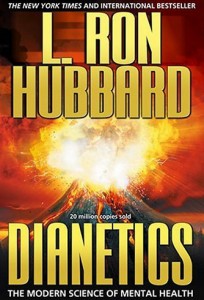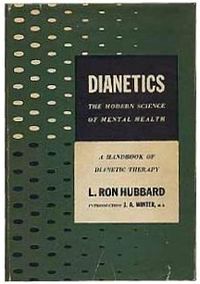 In 1950, L. Ron Hubbard published the book that changed his life, transforming him from a well known writer of pulp fiction into an even more well known leader of a worldwide organization that came to be known as the Church of Scientology.
In 1950, L. Ron Hubbard published the book that changed his life, transforming him from a well known writer of pulp fiction into an even more well known leader of a worldwide organization that came to be known as the Church of Scientology.
That book was Dianetics: The Modern Science of Mental Health, and for some time we’ve had plans to examine it in weekly installments, using a first edition copy of the book that was given to us by researcher Jeff Jacobsen.
Today, we launch that project, and announce the best part of our plans: we’ll be making use of the invaluable help of ex-Scientologist, Bay Area lawyer, and writer Vance Woodward.
Woodward spent more than 20 years in Scientology, read Hubbard obsessively, and recently published a remarkable memoir about his time in the church. In Addicted to Scientology: Overcoming the Ups & Downs of Scientoloholism, and at his blog, Woodward demonstrates a skill for describing and analyzing Hubbard’s arcane concepts with clarity and insight. And also, he’s a hoot.
So please join us as we take a weekly dive into the dense treat that is Dianetics.
 Our text, as we said, is not the hefty paperback that you will find at folding tables, being hawked on street corners by church members for $20 — the price we were quoted during a recent trip to the “org” here in New York City.
Our text, as we said, is not the hefty paperback that you will find at folding tables, being hawked on street corners by church members for $20 — the price we were quoted during a recent trip to the “org” here in New York City.
We’ll be slogging instead through the original edition that became a sensation in the summer of 1950.
And for this opening episode, we asked Vance to skip right to the first sentence of the book, which opens a ten-page section titled “Synopsis.”
Here it is, the first utterance by L. Ron Hubbard introducing his modest notion to the world…
“The creation of dianetics is a milestone for Man comparable to his discovery of fire and superior to his inventions of the wheel and arch.”
That is the import of the book we hold in our hands. Superior to the wheel.
We put it to Vance: Is it just us, or is that pretty much the dictionary definition of crackpot territory?
VANCE: Nobody would ever make a claim like that unless they had a really good reason for it, right? I suppose 1950 was a more naive era. This was a time when people mailed money orders for X-ray vision goggles.
It was also the dawn of electronic computing “brains.” Technology was advancing in real time. Anything was possible.
Could it be that scientists had completely deconstructed the human mind? That would be kind of a big deal. But who in their right mind would claim such a thing unless they had some seriously validated results?
By the way, I’m just trying to explain this from the viewpoint of a sucker. I mean myself. If any readers end up convinced that Hubbard actually developed something greater than the wheel, I take no responsibility.
THE BUNKER: Let’s back up and look at this physical object. It’s a serious-looking book (it didn’t have the volcano on the cover then), with the ponderous subtitle, “The Modern SCIENCE of Mental Health.” (Emphasis very much ours.)
That brings up an image of learned scholars in lab coats, doesn’t it? You certainly don’t get a sense from the cover that we’ll be reading about a ginned-up parlor trick that became a brief fad for bored post-war Americans who found the idea of “remembering” their experiences in the womb, séance-style, a fun time.
But let’s not get ahead of ourselves.
Still on the cover, we noticed that there’s another subtitle that the current cover no longer carries. Above Hubbard’s name are the words, “A Handbook of Dianetic Therapy.”
So even more coding for the reader that this is an established, “modern,” validated science that offers some kind of therapy for problems with mental health. And under Hubbard’s name there’s this bit of reassuring corroboration…
“Introduction by J. A. Winter, M.D.”
Winter’s intro is no longer part of the book on sale today, and perhaps we’ll get into the reason why next time. But for now, we wanted to ask you, if Hubbard was careful to create a cover that suggests a legitimate modern science, why that nutty first sentence?
By saying that his scheme — which almost no one had heard of at that point — was more important than the invention of the wheel, isn’t he giving up the game from the start? Shouldn’t any reasonable person already be running for the hills? Or is this the first of a series of brilliant gambles by a man who had made a living as a spinner of tall tales?
VANCE: Yeah, I’d figure that reasonable people would definitely select themselves out of the picture, leaving more easily beguiled folks to try out the new Dianetic therapy. And those are the same people who are more likely to perceive benefits from the therapy, wouldn’t you think?
I’m pretty sure that Hubbard lived in a mind space where subjective reality meant everything. For most people, the Emperor’s New Clothes is a statement about vanity. But for Hubbard, it was a statement of reality: if everybody believes the emperor has clothes, then the emperor has clothes.
Evidently, Hubbard had electrified Winter and John Campbell Jr., editor of Astounding Science Fiction, where a shorter version of Dianetics first appeared in the May 1950 edition. And so, maybe Hubbard was thinking, “Hey, if I’ve convinced an MD and the editor of Astounding that my therapy is worthwhile, it must be worthwhile. This must actually be important. Heck, I’ve discovered the most important thing ever. Boy, I always thought I was destined for greatness, but I never suspected I was this awesome. Holy Toledo!”
THE BUNKER: OK, but you’re suggesting here that Hubbard was buying his own good reviews from Winter and Campbell, and excitedly put out a book while thinking, my ideas are so amazing the rest of the world needs to hear them.
But isn’t there another way to look at it — that Hubbard knew he was selling the Brooklyn Bridge and that the first thing you have to do is get your mark worked up into a lather? (That he eventually ended up selling a Bridge to Total Freedom to his followers also suggests a remarkably self-aware salesman.)
VANCE: That’s the riddle. What was really going on in his mind deep down? Maybe he knew his therapy was scientifically bogus. Maybe he merely had doubts about it. Maybe he completely believed everything he said and wrote. It’s hard to know for sure, because Hubbard used language with the skill of a judo master.
Isn’t it true that the most effective salespeople have to believe in their own product? I think it’s safe to say that Hubbard quite honestly sought immortality. He wanted to be remembered as a great human being. So, he was definitely motivated to come up with the goods. Was he so motivated that he was able to trick even himself into thinking that he did come up with the goods?
Later on, Hubbard told a brief allegory having something to do with people being trapped somewhere, like in a room. One of the people discovers that the door out is simply unlocked and all anybody needs to do is walk out the door. But some of the prisoners don’t believe it and even try to prevent others from walking out the door. The room is “the trap” that Hubbard frequently referred to, and the way out is Scientology. Taking that at face value (always risky), Hubbard was saying that you should cajole, trick, mislead and otherwise force people into adopting what was for their own good. Once they see the light, their own good sense will keep them on the path to total freedom. And, deep down, he honestly believed he was doing something good. I mean, that’s him at his best! I’m sure on his darker days (most days?), he simply wanted more shoe boxes of cash to hide in his closet (because the greatest human being who ever lived deserved such things even if nobody else thought so).
Just as he could easily manipulate other people’s minds, I think he could similarly manipulate his own mind.
THE BUNKER: Well, for now, and for our own sanity, as we examine this book let’s just assume that Hubbard is on the level, and we’ll read it at face value.
Next week, we’ll quickly plow through more of Hubbard’s boasting and get to his first real assertion, the notion of a clear. Please join us!
Blogging Dianetics, part 2: The State of Clear!
Blogging Dianetics, part 3: The Meaning of Life!
Blogging Dianetics, part 4: Dynamically speaking
————
Links of Note
Tonight at 9 pm Eastern, several interesting women who left Scientology are participating in a live 3-hour web radio program. With Claire Headley, Lori Hodgson, and Nancy Many participating, there should be some interesting fireworks going off.
————
Posted by Tony Ortega on January 4, 2013 at 07:00
New to the subject? For a basic primer on Scientology, there’s this. For a light-hearted and visual look at how the church got into the crises gripping it today, check out our recent picture-story.
Former Village Voice editor Tony Ortega has written about Scientology since 1995. He’s currently working on a book about the church, and while he toils away on it he continues to monitor breaking developments around the world from an undisclosed location in an underground bunker he shares with four cats and one of them wrinkly Shar Pei dogs. Despite his super-secret security protections, you can still reach him pretty easily by sending him a message at tonyo94 AT gmail.com (Drop him a line if you’d like to get an e-mail whenever a new story is posted.) Or check in at his Facebook author page. Or follow him at Twitter: @TonyOrtega94






